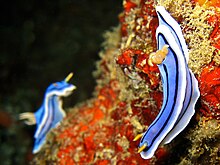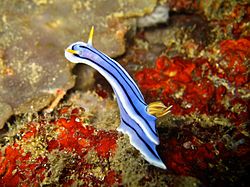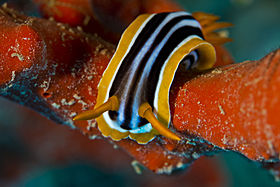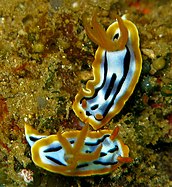Chromodoris
| Chromodoris | |
|---|---|

| |
| Chromodoris lochi | |

| |
| Chromodoris joshi in the Komodo National Park | |
| Scientific classification | |
| Domain: | Eukaryota |
| Kingdom: | Animalia |
| Phylum: | Mollusca |
| Class: | Gastropoda |
| Subclass: | Heterobranchia |
| Order: | Nudibranchia |
| Suborder: | Doridina |
| Superfamily: | Doridoidea |
| Family: | Chromodorididae |
| Genus: | Chromodoris Alder & Hancock, 1855[1] |
| Type species | |
| Doris magnifica Quoy & Gaimard, 1832
| |
| Species | |
|
See text | |
| Synonyms | |
| |
Chromodoris is a
Anatomy
Chromodoris species exhibit one of the two major body types found within Nudibranchia. There are a few major bodily features that separate chromodorids from other sea slugs.
Mantle
Dorids have a thick mantle that exists over their foot, and in some species, the mantle can have tubercles (nodules along the surface of an organism that are made of keratin)[3] of different concentrations, shapes, and sizes, providing some rigidity and protection for their soft, shell-less bodies. In most dorid species, the mantle holds toxins that defend the organism that are obtained through their diet.
Respiratory system
Chromodorids breathe oxygen principally through their gills, usually positioned in a featherlike structure located around the anus at their posterior, called the branchial plume.[4]
Phylogeny and taxonomy
The classification of the family Chromodorididae has been the subject of many studies on nudibranches in recent years,[when?] most focusing on the phylogeny and its impact on the traditional taxonomies of the genera. Chromodoris was long considered to be the most diverse genus of the Chromodorididae; however, a study published in July 2018 on Indo-pacific species of chromodorid nudibranchs has shown that the genus should be categorized more strictly, and has been narrowed down to 22 species. These species characteristically have black stripes along their bodies and linear spawning.[5]
Chemical defenses
Chromodorid nudibranchs commonly exhibit chemical defenses to protect themselves from predators. Most of the species that exhibit this behavior make use of bioactive compounds like alkaloids, diterpenes, and sesquiterpenes from the sponges they feed on. Nudibranchs can collect these compounds and store them as is, transform them, or be selectively sequestered, although there is no information on how common each mechanism is and which individual species exhibit the individual methods. Chromodorid nudibranchs in particular transport and store their toxic compounds in specialized storage glands located in strategic locations throughout the mantle, called mantle dermal formations (MDFs). These MDFs have been shown to harbor extremely high concentrations of distasteful and potent compounds in comparison to the rest of their body.[6]
Reproduction
All nudibranchs are simultaneous hermaphrodites, with each individual possessing both male and female reproductive structures. During mating, two individuals compete for the position of male by darting their penises at one another until the victor penetrates the body wall of the other and impregnating them, forcing them to act as the female, an act commonly called "penis fencing." From here, the female lays eggs into a substrate, which hatch planktonic vestigial veliger larva, who will further evolve into adults.[7]
Species
Species in the genus Chromodoris include:[8]
- Chromodoris africana Eliot, 1904
- Chromodoris aila Er. Marcus, 1961
- Chromodoris albolimbata Bergh, 1907
- Chromodoris albonotata Bergh, 1875
- Chromodoris alcalai Gosliner, 2021
- Chromodoris alternata Burn, 1957
- Rudman, 1987
- Chromodoris annae Bergh, 1877
- Chromodoris aspersa Gould, 1852
- Chromodoris balat Bonomo & Gosliner, 2020
- Chromodoris barnardi (Collingwood, 1868)
- Chromodoris baqe Bonomo & Gosliner, 2020
- Rudman, 1982
- Chromodoris briqua Marcus & Burch, 1965
- Chromodoris buchananae Gosliner & Behrens, 2000
- Rudman, 1982
- Chromodoris camoena Bergh, 1879
- Chromodoris cardinalis Bergh, 1880
- Rudman, 1982
- Chromodoris dianae Gosliner & Behrens, 1998
- Chromodoris dictya Er. Marcus & Ev. Marcus, 1970
- Chromodoris elisabethina Bergh, 1877
- Chromodoris euelpis Bergh, 1907
- Rudman, 1977
- Chromodoris inconspicua Eliot, 1904
- Chromodoris inopinata Bergh, 1905
- Chromodoris joshi Gosliner & Behrens, 1998
- Chromodoris kalawakan Bonomo & Gosliner, 2020
- Rudman, 1982
- Chromodoris lapinigensis Bergh, 1879
- Chromodoris lata Risbec, 1928
- Chromodoris lentiginosa Pease, 1871
- Chromodoris lineolata Hasselt, 1824
- Rudman, 1982
- Gaimard, 1832 : Type species.
- Chromodoris mandapamensisValdes, Mollo, & Ortea, 1999
- Chromodoris mariana Bergh, 1890
- Chromodoris marpessa Bergh, 1905
- Chromodoris michaeli Gosliner & Behrens, 1998
- Chromodoris nodulosa Bergh, 1905
- Chromodoris nona (Baba, 1953)
- Chromodoris ophthalmica Bergh, 1905
- Rudman, 1983
- Chromodoris pantharella Bergh, 1879
- Chromodoris papulosa Bergh, 1905
- Chromodoris paupera Bergh, 1877
- Chromodoris perola Ev. Marcus, 1976
- Chromodoris porcata Bergh, 1889
- Chromodoris pustulans Bergh, 1877
- Chromodoris quadricolor Rueppell & Leuckart, 1828
- Chromodoris quagga Bonomo & Gosliner, 2020
- Chromodoris roseopicta Verrill, 1900
- Chromodoris rudolphi Bergh, 1880
- Chromodoris splendens Eliot, 1904
- Chromodoris striatella Bergh, 1877
- Rudman, 1982
- Chromodoris tenuilinearis Farran, 1905
- Chromodoris tenuis Collingwood, 1881
- Rudman, 1983
- Chromodoris trouilloti Risbec, 1928
- Chromodoris venusta Bergh, 1905
- Chromodoris virginea Bergh, 1877
- Chromodoris westraliensis O'Donoghue, 1924
- Rudman, 1982
- Synonyms
- Chromodoris albonares Rudman, 1990: synonym of Goniobranchus albonares(Rudman, 1990)
- Chromodoris albopunctata Garrett, 1879: synonym of Goniobranchus albopunctatus Garrett, 1879
- Chromodoris albopustulosa Pease, 1860: synonym of Goniobranchus albopustulosus (Pease, 1860)
- Chromodoris alius Rudman, 1987: synonym of Goniobranchus alius(Rudman, 1987)
- Chromodoris agassizii: synonym of Felimare agassizii (Bergh, 1894)
- Chromodoris annulata Eliot, 1904: synonym of Goniobranchus annulatus (Eliot, 1904)
- Chromodoris antonii: synonym of Mexichromis antonii (Bertsch, 1976)
- Chromodoris aureomarginata Cheeseman, 1881: synonym of Goniobranchus aureomarginatus (Cheeseman, 1881)
- Chromodoris aureopurpurea Collingwood, 1881: synonym of Goniobranchus aureopurpureus (Collingwood, 1881)
- Chromodoris aurigera Rudman, 1990: synonym of Goniobranchus aurigerus(Rudman, 1990)
- Chromodoris australis: synonym of Thorunna australis (Risbec, 1928)
- Chromodoris banksi: synonym of Glossodoris dalli(Bergh, 1879)
- Chromodoris baumanni Bertsch, 1970: synonym of Glossodoris baumanni(Bertsch, 1970)
- Chromodoris bennetti: synonym of Hypselodoris bennetti (Angas, 1864)
- Chromodoris bimaensis Bergh, 1905: synonym Goniobranchus bimaensis Bergh, 1905
- Chromodoris binza Ev. Marcus & Er. Marcus, 1963: synonym of Felimida binza (Ev. Marcus & Er. Marcus, 1963)
- Chromodoris bistellata: synonym of Aphelodoris antillensis
- Chromodoris britoi Ortea & Pérez, 1983: synonym of Felimida britoi(Ortea & Perez, 1983)
- Chromodoris bullocki: synonym of Hypselodoris bullocki
- Chromodoris californiensis: synonym of Hypselodoris californiensis
- Chromodoris cantrainii Bergh, 1879: synonym of Felimare picta (Schultz in Philippi, 1836)
- Chromodoris carnea: synonym of Hypselodoris carnea
- Chromodoris cazae Gosliner & Behrens, 2004: synonym of Goniobranchus cazae (Gosliner & Behrens, 2004)
- Chromodoris charlottae Schrödl, 1999: synonym of Goniobranchus charlottae (Schrödl, 1999)
- Chromodoris clenchi Russell, 1935 - the harlequin blue doris: synonym of Felimida clenchi (Russell, 1935)
- Chromodoris clitonota Durvilledoris lemniscata(Quoy & Gaimard, 1832)
- Chromodoris coi Risbec, 1956: synonym of Goniobranchus coi (Risbec, 1956)
- Chromodoris collingwoodi Rudman, 1987: synonym of Goniobranchus collingwoodi(Rudman, 1987)
- Chromodoris conchyliata Yonow, 1984: synonym of Goniobranchus conchyliatus (Yonow, 1984)
- Chromodoris dalli: synonym of Glossodoris dalli(Bergh, 1879)
- Chromodoris daphne Angas, 1864: synonym of Goniobranchus daphne (Angas, 1864)
- Chromodoris decora Pease, 1860: synonym of Goniobranchus decorus (Pease, 1860)
- Chromodoris dollfusi: synonym of Hypselodoris dollfusi
- Chromodoris elegans (Cantraine, 1835): synonym of Felimare picta (Schultz in Philippi, 1836)
- Chromodoris elegantula Philippi, 1844: synonym of Felimida elegantula (Philippi, 1844)
- Chromodoris epicuria Basedow & Hedley, 1905: synonym of Goniobranchus epicurius (Basedow & Hedley, 1905)
- Chromodoris fentoni Valdés, Gatdula, Sheridan & Herrera, 2011: synonym of Felimida fentoni
- Chromodoris festiva: synonym of Mexichromis festiva (Angas, 1864)
- Chromodoris fidelis Kelaart, 1858: synonym of Goniobranchus fidelis (Kelaart, 1858)
- Chromodoris flava: synonym of Diversidoris flava (Eliot, 1904)
- Chromodoris francoisae: synonym of Mexichromis francoisae(Bouchet, 1980)
- Chromodoris galactos Rudman & Johnson in Rudman, 1985: synonym of Goniobranchus galactos(Rudman & S. Johnson, 1985)
- Chromodoris galexorum Bertsch, 1978: synonym of Felimida galexorum (Bertsch, 1978)
- Chromodoris geminus Rudman, 1987: synonym of Goniobranchus geminus(Rudman, 1987)
- Chromodoris geometrica Risbec, 1928: synonym of Goniobranchus geometricus (Risbec, 1928)
- Chromodoris ghanensis: synonym of Glossodoris ghanensis
- Chromodoris ghardagana [sic]: synonym of Hypselodoris ghardaqana (Gohar & Aboul-Ela, 1957)
- Chromodoris gleniei Kelaart, 1858: synonym of Goniobranchus gleniei (Kelaart, 1858)
- Chromodoris godeffroyana: synonym of Risbecia godeffroyana
- Chromodoris goslineri Ortea & Valdés in Ortea, Valdés & Garcia Gómez, 1996: synonym of Felimida goslineri (Ortea & Valdés, 1996)
- Chromodoris grahami Thompson, 1980: synonym of Felimida grahami
- Chromodoris haliclona: synonym of Noumea haliclona
- Chromodoris heatherae Gosliner, 1994 - Red-spotted nudibranch: synonym of Goniobranchus heatherae(Gosliner, 1994)
- Chromodoris hintuanensis Gosliner & Behrens, 1998: synonym of Goniobranchus hintuanensis (Gosliner & Behrens, 1998)
- Chromodoris hunterae Rudman, 1983: synonym of Goniobranchus hunterae(Rudman, 1983)
- Chromodoris imperialis: synonym of Risbecia imperialis(Pease, 1860)
- Chromodoris kempfi: synonym of Mexichromis kempfi
- Chromodoris kitae Gosliner, 1994: synonym of Goniobranchus kitae (Gosliner, 1994)
- Chromodoris kpone Edmunds, 1981: synonym of Felimida kpone (Edmunds, 1981)
- Chromodoris krohni Vérany, 1846: synonym of Felimida krohni (Vérany, 1846)
- Chromodoris kuniei Pruvot-Fol, 1930: synonym of Goniobranchus kuniei (Pruvot-Fol, 1930)
- Chromodoris lekker Gosliner, 1994: synonym of Goniobranchus lekker (Gosliner, 1994)
- Chromodoris lemniscata: synonym of Durvilledoris lemniscata
- Chromodoris leopardus: synonym of Rudman, 1987
- Chromodoris lilacina (Gould, 1852): synonym of Tayuva lilacina (Gould, 1852)
- Chromodoris lineata nigrolineata: synonym of Hypselodoris nigrolineata
- Chromodoris loringi Angas, 1864: synonym of Goniobranchus loringi (Angas, 1864)
- Chromodoris luteopunctata Gantes, 1962: synonym of Felimida luteopunctata (Gantès, 1962)
- Chromodoris luteorosea Rapp, 1827: synonym of Felimida luteorosea (Rapp, 1827)
- Chromodoris macfarlandi Cockerell, 1901 - Three-stripe doris: synonym of Felimida macfarlandi(Cockerell, 1901)
- Chromodoris maculosa: synonym of Hypselodoris maculosa
- Chromodoris marenzelleri Bergh, 1888: synonym of Hypselodoris festiva (A. Adams, 1861)
- Chromodoris mariei: synonym of Mexichromis mariei
- Chromodoris marislae Bertsch in Bertsch, Ferreira, Farmer, & Hayes, 1973: synonym of Felimida marislae (Bertsch, 1973)
- Chromodoris maritimais a: synonym of Hypselodoris maritima
- Chromodoris multimaculosa Rudman, 1987: synonym of Goniobranchus multimaculosus(Rudman, 1987)
- Chromodoris naiki Valdes, Mollo, & Ortea, 1999: synonym of Goniobranchus naiki(Valdés, Mollo & Ortea, 1999)
- Chromodoris neona Marcus, 1955: synonym of Felimida neona(Er. Marcus, 1955)
- Chromodoris nigrostriata a: synonym of Hypselodoris nigrostriata
- Chromodoris norrisi Farmer, 1963: synonym of Felimida norrisi (Farmer, 1963)
- Chromodoris nyalya: synonym of Hypselodoris nyalya(Ev. Marcus & Er. Marcus, 1967)
- Chromodoris obsoleta Rüppell & Leuckart, 1831: synonym of Goniobranchus obsoletus (Rüppell & Leuckart, 1831)
- Chromodoris orsinii: synonym of Felimare orsinii
- Chromodoris paulomarcioi Dominguez, Garcia & Troncoso, 2006: synonym of Felimida paulomarcioi Dominguez, Garcia & Troncoso, 2006
- Chromodoris peasei: synonym of Hypselodoris peasei
- Chromodoris perplexa: synonym of Digidentis perplexa
- Chromodoris petechialis Gould, 1852: synonym of Goniobranchus petechialis (Gould, 1852)
- Chromodoris placida: synonym of Hypselodoris placida
- Chromodoris porterae: synonym of Mexichromis porterae
- Chromodoris ponga Er. Marcus & Ev. Marcus, 1970: synonym of Felimida ponga (Er. Marcus & Ev. Marcus, 1970)
- Chromodoris preciosa Kelaart, 1858: synonym of Goniobranchus preciosus (Kelaart, 1858)
- Chromodoris purpurea Risso in Guerin, 1831: synonym of Felimida purpurea (Risso in Guérin, 1831)
- Chromodoris pusilla: synonym of Durvilledoris pusilla
- Chromodoris regalis Ortea, Caballer & Moro, 2001: synonym of Felimida regalis (Ortea, Caballer & Moro, 2001)
- Chromodoris reticulata (Quoy & Gaimard, 1832) : synonym of Goniobranchus reticulatus (Quoy & Gaimard, 1832)
- Chromodoris roboi Gosliner & Behrens, 1998: synonym of Goniobranchus roboi (Gosliner & Behrens, 1998)
- Chromodoris rodomaculata Ortea & Valdés, 1991: synonym of Felimida rodomaculata (Ortea & Valdés, 1992)
- Chromodoris rolani Ortea, 1988: synonym of Felimida rolani (Ortea, 1988)
- Chromodoris rosans Bergh, 1889: synonym of Hypselodoris rosans (Bergh, 1889)
- Chromodoris rubrocornuta Rudman, 1985: synonym of Goniobranchus rubrocornutus(Rudman, 1985)
- Chromodoris rufomaculata Pease, 1871: synonym of Goniobranchus rufomaculatus (Pease, 1871)
- Chromodoris rufomarginata (Bergh, 1890): synonym of Glossodoris rufomarginata (Bergh, 1890)
- Chromodoris runcinata Bergh, 1877: synonym of Hypselodoris infucata (Rüppell & Leuckart, 1831)
- Chromodoris ruzafai Ortea, Bacallado, & Valdes, 1992: synonym of Felimida ruzafai (Ortea, Bacallado & Valdés, 1992)
- Chromodoris saintvincentius: synonym of Hypselodoris saintvincentius
- Chromodoris sedna: synonym of Glossodoris sedna
- Chromodoris semperi nigrostriata: synonym of Hypselodoris nigrostriata
- Chromodoris sibogae: synonym of Glossodoris sibogae
- Chromodoris sinensis Rudman, 1985: synonym of Goniobranchus sinensis(Rudman, 1985)
- Chromodoris socorroensis Behrens, Gosliner & Hermosillo, 2009: synonym of Felimida socorroensis (Behrens, Gosliner & Hermosillo, 2009)
- Chromodoris sonora: synonym of Glossodoris dalli
- Chromodoris sphoni Marcus, 1971: synonym of Felimida sphoni Ev. Marcus, 1971
- Chromodoris splendida: synonym of Goniobranchus splendidus Angas, 1864
- Chromodoris tasmaniensis Bergh, 1905: synonym of Goniobranchus tasmaniensis (Bergh, 1905)
- Chromodoris tennentana Kelaart, 1859 -: synonyms: Chromodoris cavae Eliot, 1904; Chromodoris vicina: synonym of Goniobranchus tennentanus (Kelaart, 1859)
- Chromodoris tinctoria Rüppell & Leuckart, 1831 -: synonyms: Chromodoris alderi, Chromodoris reticulata: synonym of Goniobranchus tinctorius (Rüppell & Leuckart, 1828)
- Chromodoris tricolor: synonym of Hypselodoris tricolor
- Chromodoris trimarginata Winckworth, 1946: synonym of Goniobranchus trimarginatus (Winckworth, 1946)
- Chromodoris tritos Yonow, 1994: synonym of Goniobranchus tritos (Yonow, 1994)
- Chromodoris tryoni: synonym of Risbecia tryoni
- Chromodoris tumulifera Collingwood, 1881: synonym of Goniobranchus tumuliferus (Collingwood, 1881)
- Chromodoris tura: synonym of Mexichromis tura
- Chromodoris varians: synonym of Noumea varians
- Chromodoris verrieri Crosse, 1875: synonym of Goniobranchus verrieri (Crosse, 1875)
- Chromodoris vibrata Pease, 1860: synonym of Goniobranchus vibratus (Pease, 1860)
- Chromodoris villafranca: synonym of Felimare villafranca
- Chromodoris westralensis [sic]: synonym of Chromodoris westraliensis (O'Donoghue, 1924)
- Chromodoris woodwardi Rudman, 1983: synonym of Goniobranchus woodwardae(Rudman, 1983)
- Chromodoris youngbleuthi: synonym of Glossodoris rufomarginata
- Chromodoris zebra: synonym of Felimare zebra
- Chromodoris zebrina: synonym of Hypselodoris zebrina
References
- ^ Alder J. & Hancock A. (1855). A monograph of the British nudibranchiate Mollusca: with figures of all the species. The Ray Society, London. Part 7, Appendix xvii.
- ProQuest 304661522.
- ^ "Tubercles". Fishionary. May 2018.
- ^ "Basic Anatomy of the Sea Slug". The Invertebrate Collections of the University Museum of Bergen. December 2018.
- PMID 29476907– via Web of Science.
- ProQuest 1344056819.
- ^ Parducho, Vina Angelica (April 2015). "Reproduction of Chromodoris lochi". SeaLifeBase.
- S2CID 222838004.
Sources
- SEM images of the radula can be found at Thompson, T.E.; Bebbington, A. (1973). "Scanning electron microscope studies of gastropod radulae". Malacologia. 14: 147–165.
- Rudman W.B. (1977) Chromodorid opisthobranch Mollusca from East Africa and the tropical West Pacific. Zoological Journal of the Linnean Society 61: 351-397
- Rudman W.B. (1984) The Chromodorididae (Opisthobranchia: Mollusca) of the Indo-West Pacific: a review of the genera. Zoological Journal of the Linnean Society 81 (2/3): 115-273 page(s): 130
- Vaught, K.C. (1989). A classification of the living Mollusca. American Malacologists: Melbourne, FL (USA). ISBN 0-915826-22-4. XII, 195 pp.
- Rudman W.B. & Darvell B.W. (1990) Opisthobranch molluscs of Hong Kong: Part 1. Goniodorididae, Onchidorididae, Triophidae, Gymnodorididae, Chromodorididae (Nudibranchia). Asian Marine Biology 7: 31-79 page(s): 55
- Gofas, S.; Le Renard, J.; Bouchet, P. (2001). Mollusca, in: Costello, M.J. et al. (Ed.) (2001). European register of marine species: a check-list of the marine species in Europe and a bibliography of guides to their identification. Collection Patrimoines Naturels, 50: pp. 180–213
- Johnson R.F. & Gosliner T.M. (2012) Traditional taxonomic groupings mask evolutionary history: A molecular phylogeny and new classification of the chromodorid nudibranchs. PLoS ONE 7(4): e33479
















